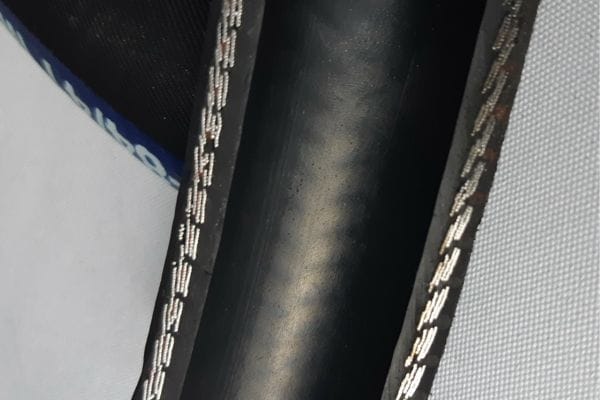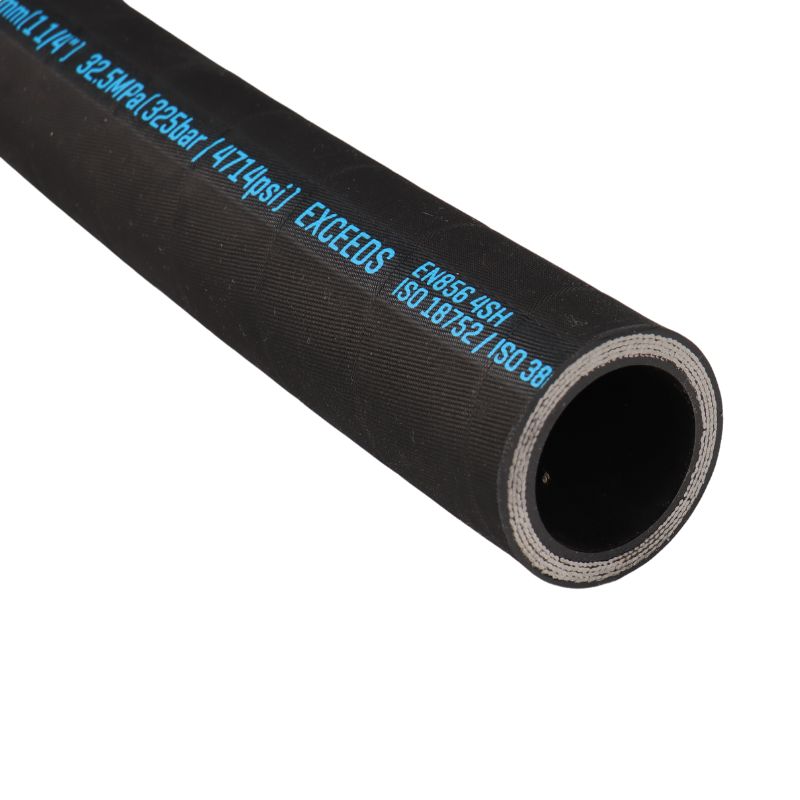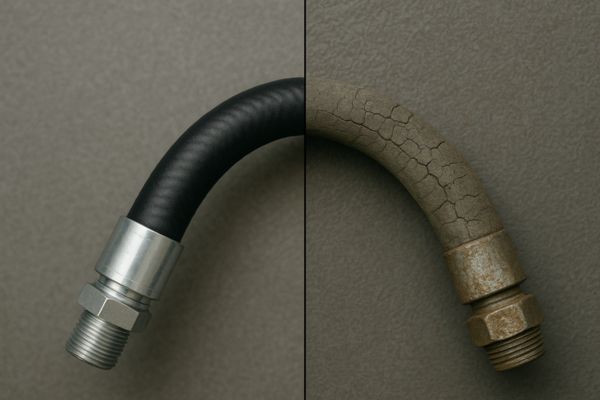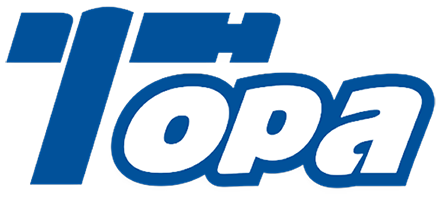Hydraulic hoses are vital for transferring fluid under pressure. Two main types dominate the market: braided hydraulic hoses and spiral hydraulic hoses. Each type has unique strengths, structures, and applications. Understanding these differences helps buyers and engineers choose the right hose for their systems.
Understanding Braided Hydraulic Hoses
What Is a Braided Hydraulic Hose?
A braided hydraulic hose is reinforced with high-tensile steel wires woven in a crisscross pattern. This structure resembles a plait, providing strength and flexibility. Most braided hoses have one or two wire layers, while special types may include three. These hoses are categorized under standards such as SAE 100R1 and SAE 100R2, making them widely accepted in industrial and mobile hydraulic systems.
Structure of Braided Hoses
Braided hoses use overlapping steel wires arranged in alternating directions. This mesh distributes stress evenly and resists pressure. Unlike spiral hoses, the end view of a braided hose looks disorganized, with steel bundles grouped together instead of clear rings. This design supports flexibility, making braided hoses easy to route through tight hydraulic assemblies without sacrificing strength.

Applications of Braided Hoses
- Agricultural machinery: return lines, steering systems, and lifting functions.
- Construction equipment: auxiliary hydraulic circuits and loader arms.
- Industrial systems: material handling equipment and presses.
- General hydraulics: return lines, oil circulation, and lubrication systems.
Advantages of Braided Hoses
- Small bending radius allows use in compact equipment.
- Excellent flexibility makes installation easier.
- Lightweight design reduces overall machine weight.
- Cost efficiency makes them affordable compared to spiral hoses.
- Compatibility with standard fittings ensures easy replacement.
Limitations of Braided Hoses
- Limited pressure capacity: they cannot handle extremely high working pressures.
- Shorter fatigue life: pulsating pressure and impulse loads reduce lifespan.
- Prone to wear: constant bending or external abrasion can cause early damage.
- Temperature sensitivity: excessive heat reduces hose elasticity and sealing ability.
Understanding Spiral Hydraulic Hoses
What Is a Spiral Hydraulic Hose?
A spiral hydraulic hose is reinforced with several layers of high-strength steel wire wound in a helical pattern. Each layer alternates its winding direction to distribute stress evenly. This construction provides exceptional durability and makes spiral hoses suitable for extreme pressure and demanding hydraulic systems. Most spiral hoses have four or six layers, classified under SAE standards such as R12, R13, and R15.
Structure of Spiral Hoses
The wires in spiral hoses are tightly wound in a continuous helix. One layer spirals clockwise, while the next spirals counter-clockwise, ensuring balanced force distribution. When viewed from the end, the reinforcement appears like tree rings, with clear, uniform layers. This structured pattern gives spiral hoses superior strength and consistent performance under repeated impulses.

Applications of Spiral Hoses
- Mining equipment like excavators, loaders, and drills.
- Construction machinery, including bulldozers and cranes.
- Hydraulic power units and industrial presses.
- High-pressure circuits, where stability and reliability are critical.
- Oil and gas equipment, requiring strong resistance to pressure fluctuations.
Advantages of Spiral Hoses
- High pressure capacity up to 70 MPa or more.
- Excellent impulse resistance, making them reliable under pressure surges.
- Durability in harsh environments, including mining and construction.
- Extended service life, especially in continuous heavy-duty cycles.
- Stable flow performance, even with pressure spikes.
Limitations of Spiral Hoses
- Reduced flexibility compared to braided hoses.
- Larger bend radius, limiting use in compact installations.
- Higher cost due to complex manufacturing.
- Heavier weight, which can add stress to hydraulic systems.
- Difficult installation in confined or narrow routing areas.
| Feature | Braided Hydraulic Hose | Spiral Hydraulic Hose |
| Structure | Cross-woven steel wires | Helical wound steel wires |
| Common Layers | 1–2 layers (rarely 3) | 4–6 layers |
| Flexibility | High | Low |
| Pressure Range | Low to medium (up to 40 MPa) | High (42–70 MPa+) |
| Fatigue Resistance | Lower under impulses | Higher impulse resistance |
| Cost | More affordable | More expensive |
| Typical Use | Farm equipment, light machinery | Mining, construction, heavy equipment |
Hose Performance and Ratings
Spiral Hose Performance and Ratings
Working pressure range: 42–70 MPa Spiral hoses are engineered for very high working pressures. Depending on the series, they can safely handle ranges between 42 MPa and 70 MPa. This makes them suitable for heavy-duty hydraulic circuits in construction and mining equipment.
Impulse cycles: Exceeding 1,000,000 Spiral hydraulic hoses are designed for extreme impulse resistance. Many models can withstand over one million impulse cycles without failure. This durability makes them ideal for hydraulic systems with frequent pressure surges, such as excavators, bulldozers, and drilling rigs, where pulsating loads are constant.
Temperature range: -40°C to +120°C With compatible hydraulic fluids, spiral hoses maintain performance across wide temperature ranges. They function reliably in freezing outdoor environments and in high-heat industrial applications. Special hose covers are also available to resist abrasion, ozone, and higher temperatures if required by the operating environment.
Common standards: SAE and EN certifications Spiral hoses follow international standards to guarantee quality and safety. Typical models include SAE 100R12, SAE 100R13, SAE 100R15, EN 856 4SP, and EN 856 4SH. These certifications define hose structure, pressure ratings, and impulse requirements, ensuring global compatibility and consistent performance.
| Parameter | Details |
| Working pressure | 42–70 MPa, depending on series; ideal for heavy-duty hydraulic circuits |
| Impulse cycles | Exceeds 1,000,000; excellent for systems with constant pressure surges |
| Temperature range | -40°C to +120°C with compatible fluids; higher with special covers |
| Standards | SAE 100R12, SAE 100R13, SAE 100R15, EN 856 4SP, EN 856 4SH |
| Applications | Mining, construction, drilling rigs, hydraulic power units |
Braided Hose Performance and Ratings
Typical working pressure: up to 40 MPa
Braided hydraulic hoses are generally rated for low to medium pressures, reaching up to 40 MPa depending on hose size and construction. This makes them suitable for return lines, steering systems, and auxiliary circuits in agricultural or light construction machinery.
Impulse resistance: moderate Compared with spiral hoses, braided hoses have lower impulse endurance. They can handle moderate cycling, but frequent or strong pressure surges shorten service life. In impulse-heavy systems such as excavators or drilling rigs, spiral hoses are preferred.
Temperature range: -40°C to +100°C Braided hoses operate reliably in temperatures from -40°C up to +100°C. With specialized materials, some versions can withstand up to +120°C. This makes them effective in outdoor equipment, industrial machinery, and hydraulic return lines exposed to moderate heat. For higher heat, special hose covers are required.
Standards: SAE and EN certifications Common braided hose standards include SAE 100R1, SAE 100R2, EN 853 1SN, and EN 853 2SN. These standards define performance requirements, pressure ratings, and testing methods. Compliance ensures hoses are safe, interchangeable, and globally available, providing reliability for OEMs and maintenance operations.
| Parameter | Details |
| Working pressure | Up to 40 MPa; suitable for low to medium-pressure systems |
| Impulse resistance | Moderate; shorter life in high-impulse or surge-heavy systems |
| Temperature range | -40°C to +100°C (up to +120°C with special materials) |
| Standards | SAE 100R1, SAE 100R2, EN 853 1SN, EN 853 2SN |
| Applications | Agricultural machinery, return lines, steering systems, light equipment |
How to Choose Between Braided and Spiral Hoses
Step 1: Evaluate System Pressure
System pressure is the most critical factor when selecting hydraulic hoses. Braided hoses perform well in medium-pressure circuits, typically under 40 MPa, making them suitable for return lines and steering systems. Spiral hoses, on the other hand, are built for extremely high pressures above 40 MPa and are safer in heavy-duty equipment. Always compare your system’s maximum pressure with the hose’s rated working and burst pressures before choosing.
Step 2: Check Installation Space
Installation space greatly affects hose choice. Braided hydraulic hoses are highly flexible and can bend tightly, which is ideal for tractors, forklifts, or compact hydraulic units. Spiral hoses need more room because of their larger bend radius, making them more suitable for mining machines or cranes with spacious layouts. Forcing spiral hoses into tight spaces may cause kinking or premature wear, so routing must always be planned carefully.

Step 3: Consider Budget
Cost is an important factor for both OEMs and maintenance teams. Braided hoses are affordable and offer good performance in general-purpose applications, reducing upfront expenses. Spiral hoses, while more expensive, deliver a longer service life in high-pressure conditions. This reduces downtime and lowers long-term maintenance costs. Businesses must weigh the balance between initial purchase price and lifecycle cost savings when deciding between braided and spiral hoses.
Step 4: Match with Standards
Choosing a hose that complies with recognized international standards ensures safety and compatibility.
- Braided hoses: SAE 100R1, SAE 100R2, EN 853 1SN, EN 853 2SN.
- Spiral hoses: SAE 100R12, SAE 100R13, SAE 100R15, EN 856 4SP, EN 856 4SH. These standards define hose construction, pressure ratings, impulse resistance, and testing methods. Using standardized hoses ensures replacement availability worldwide, prevents compatibility issues, and guarantees reliable performance under specified working conditions.
Step 5: Maintenance Planning
Maintenance requirements vary by hose type. Braided hoses withstand frequent bending but degrade faster under repeated pressure impulses. They should be inspected often for leaks, cracks, or wear. Spiral hoses excel in heavy-duty cycles with continuous high loads and strong impulses. Their longer service life reduces downtime and replacement frequency. Planning maintenance based on hose type ensures system reliability and lowers unexpected hydraulic failures in critical equipment.
Common Problems in Hydraulic Hoses
Issues with Braided Hoses
Burst under high pressure Braided hoses are built for medium pressure, not extreme loads. If system pressure exceeds their rating, the reinforcement can fail suddenly. This results in hose bursts, fluid leakage, equipment shutdown, and even safety hazards. Operators must always check manufacturer data before using braided hoses in demanding systems.
Kinking due to repeated bends While braided hoses are flexible, over-bending or routing them too tightly can cause kinks. Kinking restricts fluid flow, increases turbulence, and puts extra stress on hose walls. Over time, this weakens the hose structure, making it prone to cracking or internal damage. Proper routing and bend radius guidelines help prevent this issue.
Shorter service life in impulse-heavy systems Braided hoses have lower impulse cycle ratings than spiral hoses. In hydraulic systems with frequent pressure spikes, the reinforcement fatigues faster. This leads to shorter service life, more frequent replacements, and higher long-term costs. For equipment exposed to continuous pressure pulsations, spiral hoses are often a better choice.
| Problem | Cause/Impact | Solution/Prevention |
| Burst under high pressure | Exceeding rated pressure causes reinforcement failure, leaks, and shutdown | Use within pressure rating; choose spiral hoses for high-pressure |
| Kinking due to repeated bends | Tight routing restricts flow and stresses hose walls | Follow minimum bend radius; avoid sharp bends |
| Shorter service life in impulse-heavy systems | Lower impulse resistance causes faster fatigue | Use spiral hoses in high-impulse systems; inspect regularly |

Issues with Spiral Hoses
Harder to install in tight spaces Spiral hoses have a larger bend radius, making them less flexible. In machines with compact layouts, installation can be difficult. Forcing a spiral hose into a small space risks twisting or overstressing it, which accelerates wear and reduces performance. Careful system design and routing are necessary.
Heavier weight adds load to connections Spiral hoses contain four to six steel wire layers, which increases weight. This extra weight transfers stress to hose fittings, clamps, and adapters. Over time, the added load may loosen connections, cause fitting leaks, or even damage mounting points. Using proper clamps and support brackets is essential to reduce strain.
Higher replacement cost Spiral hoses are more expensive because of their multi-layer wire construction and advanced durability. While they last longer, the initial purchase price and replacement costs are higher than braided hoses. For companies managing large fleets, this can significantly impact maintenance budgets unless offset by reduced downtime.
| Problem | Cause/Impact | Solution/Prevention |
| Harder to install in tight spaces | Larger bend radius makes routing difficult | Design layout with enough space; avoid forced bending |
| Heavier weight adds load to connections | Multi-layer wire increases stress on fittings | Use proper clamps and supports; check connections regularly |
| Higher replacement cost | More complex construction raises cost | Plan maintenance budgets; balance cost with reduced downtime |
Maintenance Tips for Longer Hose Life
Regular Inspections
Hydraulic hoses should be checked routinely for cracks, bulges, abrasion, or fluid leaks. Small surface defects can quickly worsen under pressure. Replace hoses before they completely fail to prevent costly downtime and potential safety risks. Using a scheduled inspection plan helps extend system reliability and reduces unexpected failures.
Correct Installation
Improper installation is a common cause of hose failure. Avoid routing hoses with bends sharper than the minimum bend radius specified by the manufacturer. Prevent twisting during assembly, as torsion stresses the reinforcement wires. Secure hoses with clamps to reduce vibration and movement that could accelerate wear.
Proper Storage
Storage conditions significantly affect hose life. Keep hoses in a dry, cool place away from moisture and extreme heat. Avoid direct sunlight, which degrades rubber covers and weakens flexibility. Protect hoses from chemicals, oils, and solvents that may corrode the outer layer. Correct storage preserves hose performance until installation.
Use Matching Fittings
Always use fittings and adapters designed for the selected hose type and size. Mismatched fittings can cause poor sealing, leaks, and premature failures under pressure. Follow SAE or ISO fitting standards to ensure compatibility. Using original or approved fittings also makes future replacements faster and more reliable.
Final Conclusion
By matching hose type to your working pressure, installation space, and maintenance needs, you can extend service life and reduce downtime. Both braided and spiral hoses follow strict international standards, ensuring compatibility and reliability across industries.
👉 Looking for a trusted hydraulic hose supplier?
At Topa, we provide high-quality braided and spiral hydraulic hoses, fully tested to international standards, with customization options for your unique applications.
📩 Send us your inquiry today and our team will provide you with tailored solutions, competitive pricing, and fast delivery to keep your business running smoothly.
FAQ
What is the main difference between braided and spiral hydraulic hoses?
Braided hoses use woven steel wires and offer high flexibility, while spiral hoses use multiple helical wire layers, providing higher pressure resistance and impulse life.
Which hydraulic hose is better for high-pressure applications?
Spiral hoses are designed for extreme pressures, typically ranging from 42–70 MPa. They are recommended for mining, construction, and heavy-duty hydraulic systems.
When should I choose braided hydraulic hoses?
Braided hoses are ideal for low to medium-pressure applications, especially in agricultural machinery, return lines, and equipment requiring tight routing.
How long do braided and spiral hoses last?
Service life depends on pressure, impulse cycles, and environment. Braided hoses wear faster in impulse-heavy systems, while spiral hoses can exceed one million cycles.
What international standards apply to hydraulic hoses?
Braided hoses commonly meet SAE 100R1, 100R2, EN 853 1SN, 2SN. Spiral hoses follow SAE 100R12, 100R13, 100R15, EN 856 4SP, 4SH.
How can I extend the lifespan of hydraulic hoses?
Regular inspections, proper installation, correct storage, and using compatible fittings help maximize hose performance and reduce costly failures.







